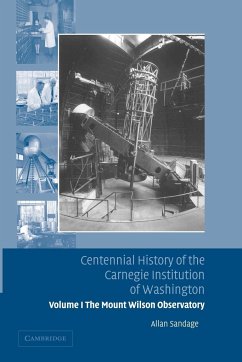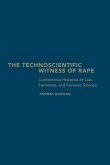Allan Sandage
Centennial History of the Carnegie Institution of Washington
Allan Sandage
Centennial History of the Carnegie Institution of Washington
- Broschiertes Buch
- Merkliste
- Auf die Merkliste
- Bewerten Bewerten
- Teilen
- Produkt teilen
- Produkterinnerung
- Produkterinnerung
This 2005 book is an exciting exploration of the development of astrophysics.
Andere Kunden interessierten sich auch für
![Centennial Campaign Centennial Campaign]() John S. GrayCentennial Campaign28,99 €
John S. GrayCentennial Campaign28,99 €![Secularism and Its Opponents from Augustine to Solzhenitsyn Secularism and Its Opponents from Augustine to Solzhenitsyn]() E. KennedySecularism and Its Opponents from Augustine to Solzhenitsyn63,99 €
E. KennedySecularism and Its Opponents from Augustine to Solzhenitsyn63,99 €![Multilevel Synthesis Multilevel Synthesis]() Daniel CourgeauMultilevel Synthesis74,99 €
Daniel CourgeauMultilevel Synthesis74,99 €![Fool Proof Fool Proof]() Tess Wilkinson-RyanFool Proof22,99 €
Tess Wilkinson-RyanFool Proof22,99 €![The Inevitable Hour The Inevitable Hour]() Emily K AbelThe Inevitable Hour33,99 €
Emily K AbelThe Inevitable Hour33,99 €![The Technoscientific Witness of Rape The Technoscientific Witness of Rape]() Andrea QuinlanThe Technoscientific Witness of Rape90,99 €
Andrea QuinlanThe Technoscientific Witness of Rape90,99 €![The Social Leap The Social Leap]() William Von HippelThe Social Leap19,99 €
William Von HippelThe Social Leap19,99 €-
-
-
This 2005 book is an exciting exploration of the development of astrophysics.
Hinweis: Dieser Artikel kann nur an eine deutsche Lieferadresse ausgeliefert werden.
Hinweis: Dieser Artikel kann nur an eine deutsche Lieferadresse ausgeliefert werden.
Produktdetails
- Produktdetails
- Verlag: Cambridge University Press
- Seitenzahl: 662
- Erscheinungstermin: 9. Oktober 2012
- Englisch
- Abmessung: 229mm x 152mm x 35mm
- Gewicht: 943g
- ISBN-13: 9781107412392
- ISBN-10: 1107412390
- Artikelnr.: 37465950
- Herstellerkennzeichnung
- Produktsicherheitsverantwortliche/r
- Europaallee 1
- 36244 Bad Hersfeld
- gpsr@libri.de
- Verlag: Cambridge University Press
- Seitenzahl: 662
- Erscheinungstermin: 9. Oktober 2012
- Englisch
- Abmessung: 229mm x 152mm x 35mm
- Gewicht: 943g
- ISBN-13: 9781107412392
- ISBN-10: 1107412390
- Artikelnr.: 37465950
- Herstellerkennzeichnung
- Produktsicherheitsverantwortliche/r
- Europaallee 1
- 36244 Bad Hersfeld
- gpsr@libri.de
Foreword Richard A. Meserve
Acknowledgements
Prologue
Part I. Before the Beginning (1542-1904): 1. A telegram
2. The origin of a name
3. Three observatories for Mount Wilson before the real one
4. The creation of the Carnegie Institution and its initial Astronomy Advisory Committee
Part II. Creation of the Observatory and the First Scientific Results: 5. The instruments of detection: solar telescopes, coelostats, spectrographs and spectra
6. Snow, hale, frost and gale: just the right people to study storms on the sun
7. Tower telescopes and magnetic fields and cycles
8. Pioneers of peering: the scientific staff in the early years (1904-9)
9. Solar physics: the intermediate years (1910-30)
10. Yet more solar physics: motions on the surface, clocks in the gravity field and the reality of prominences
Part III. The Beginning of Nighttime Sidereal Astronomy at Mount Wilson: 11. The coming of the 60-inch and 100-inch reflectors
12. Life on the mountain
13. Anatomy of an observatory
Part IV. Preparation for an Understanding of Stellar Evolution and Galactic Structure: 14. Galactic structure in the raw
15. Spectral classification and the invention of spectroscopic parallaxes
16. Radial velocity
17. Globular star clusters and the galactocentric revolution
18. Galactic rotation: Stromberg, Lindblad and Oort
19. The Carnegie Meridian Astrometry Department at the Dudley Observatory
20. Absolute magnitudes from direct parallaxes and stellar motions
21. Threads leading to the population concept that became the fabric of evolution
Part V. Physics of the Stars and the Interstellar Medium: 22. Five problems in astrophysics
23. Long-term research associates and short-term visitors
24. Interstellar gas, instruments and the spiral arms of the galaxy
Part VI. Observational Cosmology and the Code of Stellar Evolution: 25. Observational cosmology I: galaxy classification and the discovery of cepheids
26. Observational cosmology II: the expansion of the universe and the search for the curvature of space
27. Down more corridors of time
28. The observational approach to stellar evolution
Epilogue
Abbreviations
Notes
Bibliography
Index.
Acknowledgements
Prologue
Part I. Before the Beginning (1542-1904): 1. A telegram
2. The origin of a name
3. Three observatories for Mount Wilson before the real one
4. The creation of the Carnegie Institution and its initial Astronomy Advisory Committee
Part II. Creation of the Observatory and the First Scientific Results: 5. The instruments of detection: solar telescopes, coelostats, spectrographs and spectra
6. Snow, hale, frost and gale: just the right people to study storms on the sun
7. Tower telescopes and magnetic fields and cycles
8. Pioneers of peering: the scientific staff in the early years (1904-9)
9. Solar physics: the intermediate years (1910-30)
10. Yet more solar physics: motions on the surface, clocks in the gravity field and the reality of prominences
Part III. The Beginning of Nighttime Sidereal Astronomy at Mount Wilson: 11. The coming of the 60-inch and 100-inch reflectors
12. Life on the mountain
13. Anatomy of an observatory
Part IV. Preparation for an Understanding of Stellar Evolution and Galactic Structure: 14. Galactic structure in the raw
15. Spectral classification and the invention of spectroscopic parallaxes
16. Radial velocity
17. Globular star clusters and the galactocentric revolution
18. Galactic rotation: Stromberg, Lindblad and Oort
19. The Carnegie Meridian Astrometry Department at the Dudley Observatory
20. Absolute magnitudes from direct parallaxes and stellar motions
21. Threads leading to the population concept that became the fabric of evolution
Part V. Physics of the Stars and the Interstellar Medium: 22. Five problems in astrophysics
23. Long-term research associates and short-term visitors
24. Interstellar gas, instruments and the spiral arms of the galaxy
Part VI. Observational Cosmology and the Code of Stellar Evolution: 25. Observational cosmology I: galaxy classification and the discovery of cepheids
26. Observational cosmology II: the expansion of the universe and the search for the curvature of space
27. Down more corridors of time
28. The observational approach to stellar evolution
Epilogue
Abbreviations
Notes
Bibliography
Index.
Foreword Richard A. Meserve
Acknowledgements
Prologue
Part I. Before the Beginning (1542-1904): 1. A telegram
2. The origin of a name
3. Three observatories for Mount Wilson before the real one
4. The creation of the Carnegie Institution and its initial Astronomy Advisory Committee
Part II. Creation of the Observatory and the First Scientific Results: 5. The instruments of detection: solar telescopes, coelostats, spectrographs and spectra
6. Snow, hale, frost and gale: just the right people to study storms on the sun
7. Tower telescopes and magnetic fields and cycles
8. Pioneers of peering: the scientific staff in the early years (1904-9)
9. Solar physics: the intermediate years (1910-30)
10. Yet more solar physics: motions on the surface, clocks in the gravity field and the reality of prominences
Part III. The Beginning of Nighttime Sidereal Astronomy at Mount Wilson: 11. The coming of the 60-inch and 100-inch reflectors
12. Life on the mountain
13. Anatomy of an observatory
Part IV. Preparation for an Understanding of Stellar Evolution and Galactic Structure: 14. Galactic structure in the raw
15. Spectral classification and the invention of spectroscopic parallaxes
16. Radial velocity
17. Globular star clusters and the galactocentric revolution
18. Galactic rotation: Stromberg, Lindblad and Oort
19. The Carnegie Meridian Astrometry Department at the Dudley Observatory
20. Absolute magnitudes from direct parallaxes and stellar motions
21. Threads leading to the population concept that became the fabric of evolution
Part V. Physics of the Stars and the Interstellar Medium: 22. Five problems in astrophysics
23. Long-term research associates and short-term visitors
24. Interstellar gas, instruments and the spiral arms of the galaxy
Part VI. Observational Cosmology and the Code of Stellar Evolution: 25. Observational cosmology I: galaxy classification and the discovery of cepheids
26. Observational cosmology II: the expansion of the universe and the search for the curvature of space
27. Down more corridors of time
28. The observational approach to stellar evolution
Epilogue
Abbreviations
Notes
Bibliography
Index.
Acknowledgements
Prologue
Part I. Before the Beginning (1542-1904): 1. A telegram
2. The origin of a name
3. Three observatories for Mount Wilson before the real one
4. The creation of the Carnegie Institution and its initial Astronomy Advisory Committee
Part II. Creation of the Observatory and the First Scientific Results: 5. The instruments of detection: solar telescopes, coelostats, spectrographs and spectra
6. Snow, hale, frost and gale: just the right people to study storms on the sun
7. Tower telescopes and magnetic fields and cycles
8. Pioneers of peering: the scientific staff in the early years (1904-9)
9. Solar physics: the intermediate years (1910-30)
10. Yet more solar physics: motions on the surface, clocks in the gravity field and the reality of prominences
Part III. The Beginning of Nighttime Sidereal Astronomy at Mount Wilson: 11. The coming of the 60-inch and 100-inch reflectors
12. Life on the mountain
13. Anatomy of an observatory
Part IV. Preparation for an Understanding of Stellar Evolution and Galactic Structure: 14. Galactic structure in the raw
15. Spectral classification and the invention of spectroscopic parallaxes
16. Radial velocity
17. Globular star clusters and the galactocentric revolution
18. Galactic rotation: Stromberg, Lindblad and Oort
19. The Carnegie Meridian Astrometry Department at the Dudley Observatory
20. Absolute magnitudes from direct parallaxes and stellar motions
21. Threads leading to the population concept that became the fabric of evolution
Part V. Physics of the Stars and the Interstellar Medium: 22. Five problems in astrophysics
23. Long-term research associates and short-term visitors
24. Interstellar gas, instruments and the spiral arms of the galaxy
Part VI. Observational Cosmology and the Code of Stellar Evolution: 25. Observational cosmology I: galaxy classification and the discovery of cepheids
26. Observational cosmology II: the expansion of the universe and the search for the curvature of space
27. Down more corridors of time
28. The observational approach to stellar evolution
Epilogue
Abbreviations
Notes
Bibliography
Index.








